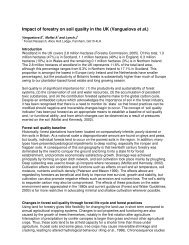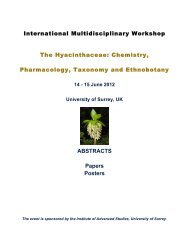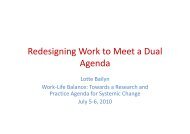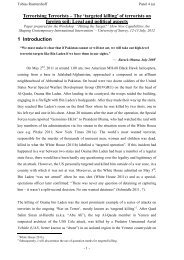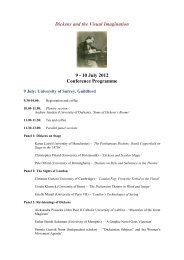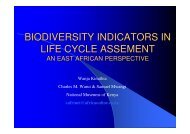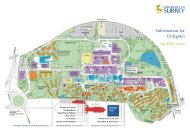Arena presentation - Institute of Advanced Studies
Arena presentation - Institute of Advanced Studies
Arena presentation - Institute of Advanced Studies
You also want an ePaper? Increase the reach of your titles
YUMPU automatically turns print PDFs into web optimized ePapers that Google loves.
Expert Workshop on Definition <strong>of</strong> Best Indicators for<br />
Biodiversity and Soil Quality<br />
for Life Cycle Assessment (LCA)<br />
12 - 13 June 2006<br />
Towards the identification and<br />
calculation <strong>of</strong> characterization<br />
factors for land use in western<br />
Argentina<br />
<strong>Arena</strong>, A.P., Civit, B.<br />
Universidad Tecnológica Nacional – Facultad Regional Mendoza<br />
Laboratorio de Ambiente Humano y Vivienda – INCIHUSA (CONICET)<br />
2006, International Year <strong>of</strong> Deserts and Desertification,
DESERTIFICATION<br />
“The land degradation in arid, semiarid and sub-humid dry<br />
regions resulting from different factors, such as climatic<br />
variations and human activities (UNCCD, 1995:7)”.<br />
Argentina: : Two thirds <strong>of</strong> its territory presents desertification<br />
symptoms at different degrees.<br />
Mendoza: The artificial oasis represents 2-4% 2<br />
<strong>of</strong> the<br />
provincial area, and concentrates 98,5% <strong>of</strong> the population,<br />
while 98 % <strong>of</strong> the province are lands without irrigation.<br />
The proximate causes identified are: diminution <strong>of</strong> water<br />
volume in rivers due to increasing extraction upstream in the<br />
oasis, expansion <strong>of</strong> agricultural frontier (vineyards), felling<br />
<strong>of</strong> trees from natural forests (Prosopis(<br />
spp,<br />
early XX<br />
century), cattle raising beyond the load capacity <strong>of</strong> fields<br />
(overpasturing)) (Abraham 2004).
IDENTIFICATION OF INDICATORS<br />
However, evidence from empirical case studies shows that<br />
desertification is determined by different combinations <strong>of</strong><br />
proximate causes and underlying driving forces which<br />
include coupled socioeconomic and biophysical factors.<br />
Even though there is consensus in the need <strong>of</strong> account on<br />
indicators and benchmarks, from the methodological point <strong>of</strong><br />
view the problem arises since there are different realities to<br />
compare, and no global set <strong>of</strong> indicators could reveal the<br />
complexity <strong>of</strong> human environment systems inherent to<br />
dryland change (GEIST et al 2004).<br />
For the case <strong>of</strong> Mendoza, based on an interdisciplinary<br />
conception, a first method was structured and applied<br />
(Abraham 2004)
Methodology for the definition <strong>of</strong> Indicators<br />
1) Inventory <strong>of</strong> factors and desertification processes for environmental unit<br />
(ecosystems). Basic information about the physical (abiotic potential),<br />
biological and socio-economical aspects (anthropic use) is acquired (remote<br />
sensing, information from the field) and mapped, organized in a GIS.<br />
2) This information is translated into indicators for obtaining:<br />
the fragility degree <strong>of</strong> the ecosystem for desertification (summing up all<br />
the indicators for the physic-biological support, like salinity and alkalinity<br />
<strong>of</strong> soil, water and wind erosion, soil depth and texture, vegetal cover and<br />
stratification, aridity index, soil freezing).<br />
the degree <strong>of</strong> anthropogenic pressure which is acting over those<br />
ecosystems (summing up all the indicators which are related with the<br />
resources demand from social groups, like population density, animal load,<br />
use <strong>of</strong> wood as fuel, poverty index ).<br />
3) The relationship between the fragility and the anthropogenic pressure for<br />
ecosystem gives the Risk <strong>of</strong> desertification <strong>of</strong> each ecosystem, which shows<br />
the state and the main indicators leading the process, being natural or<br />
anthropogenic.<br />
Map
Program to Combat Desertification and<br />
Drought Mitigation in South America<br />
Participants: Argentina, Bolivia, Brasil, , Chile, Ecuador, Perú<br />
Framework: the same suggested by the European Environmental<br />
Agency: Drivers-Pressure<br />
Pressure-State-Impacts-Responses, , also used in<br />
the MEDRAP, DISMED, DESERTLINK, an others programs.<br />
The different desertification set <strong>of</strong> indicators proposed by each<br />
country are being consolidated. Currently (aggregated list):<br />
•28 State Indicators<br />
•13 Pressure Indicators<br />
•20 Response Indicators<br />
•66 Impact indicators<br />
All <strong>of</strong> them include abiotic (soil, water, climate), biophysical (flora,<br />
fauna), socio-economical (use <strong>of</strong> land, population, poverty), and<br />
institutional and organizational aspects (N° <strong>of</strong> institutions, existence<br />
<strong>of</strong> laws, programs related with land degradation).
Problems to be solved (some <strong>of</strong> them…)<br />
Even though there have being progresses in the definition <strong>of</strong><br />
indicators for measuring the state and risk <strong>of</strong> desertification,<br />
there is no currently a consensus on a set <strong>of</strong> suitable indicators.<br />
The discussion about it is still in progress.<br />
The list <strong>of</strong> indicators is very extensive and must be revised<br />
according to relevant criteria as SMART (Specific,(<br />
Measurable,<br />
Achievable, Relevant and Time-bound (Schomaker(<br />
Schomaker, , 1997)<br />
It assumes a fairly detailed knowledge <strong>of</strong> local aspects<br />
It requires data on the previous history <strong>of</strong> land conversion<br />
There is a paucity <strong>of</strong> knowledge on many <strong>of</strong> these elements.<br />
The aim <strong>of</strong> the indicators developed within the UNCCD<br />
framework (e.g. Production <strong>of</strong> Proposals for regional planning,<br />
establishing zones for possible uses and restrictions) is different<br />
from that <strong>of</strong> LCA. Their list <strong>of</strong> indicators must be adapted for<br />
LCA purposes.
REFERENCES<br />
Abraham, E. (2004) Experiencia Argentina vinculada con la obtención n y<br />
evaluación n de indicadores de desertificación.<br />
La utilización n de indicadores socio-econ<br />
económicos en el estudio y la lucha<br />
contra la desertificación: acuerdos, discrepancias y problemas conceptuales<br />
subyacentes. Torres, L., Montaña, a, E., Abraham, E., Torres, E., Pastor, G.<br />
Urbina, S. In press ub Revista Estudios Interdisciplinarios de América<br />
Latina y el Caribe, , Vol. 16, No. 2 (2005) <strong>Institute</strong> <strong>of</strong> Latin American<br />
History and Culture, Tel Aviv University, Tel Aviv.<br />
Mathilde Snel and Alexandra Bot “Some suggested indicators for Land<br />
Degradation Assessment <strong>of</strong> Drylands”. . LADA project.<br />
GEIST, H., LAMBIN, E. Dynamic Causal Patterns <strong>of</strong> Desertification.<br />
BioScience • September 2004 / Vol. 54 No. 9<br />
ROIG, F. et al., 1983. Documento de base para la elaboración del Plan<br />
Nacional de Acción de Lucha contra la Desertificación. . Mendoza, 78p
Desertification in South America
Risk <strong>of</strong> desertification in Mendoza
Methodology…<br />
5) This methodology gives a picture <strong>of</strong> the situation. In order to be able to<br />
have an evolution <strong>of</strong> the process, a baseline must be obtained, which is<br />
determined using data from historic reports, archeological reports, and reports<br />
from different disciplines (dendrocronology, historic climatology,<br />
etnobothanics, geomorfology, etnohistory, palinology, etc). By comparison <strong>of</strong><br />
historic reports (documental sources, travelers notebooks) with the<br />
environmental ones, it’s possible to assess the changes between the current<br />
situation and the one <strong>of</strong> our base ecosystem.<br />
The indicators have been developed by working with local stakeholders and<br />
taking into account their different perceptions <strong>of</strong> desertification, land use type<br />
and decision-making processes.<br />
The methodology is innovative in that it allows both bottom-up and topdown<br />
flows <strong>of</strong> information. This is fundamental to the success <strong>of</strong> selecting the most<br />
effective land management practices to mitigate land degradation, and<br />
provides indicators for the identification <strong>of</strong> desertification risk, as well as for<br />
management methods and techniques.
Indicators<br />
State Indicators (aridity index, standard index <strong>of</strong> precipitation, surface &<br />
underground water availability, index <strong>of</strong> hydric poverty, water quality, n° n <strong>of</strong><br />
wells per area unit, % <strong>of</strong> furrows, % <strong>of</strong> dunes, slope grade, electrical<br />
conductivity degree, alkalinity, sodicity, , organic matter content, flora and<br />
fauna species at extinction risk, degradation state <strong>of</strong> vegetation, dominant<br />
species, flora and fauna stratification, % <strong>of</strong> surface under different ownership<br />
forms, producers distribution by amount <strong>of</strong> area, urban and rural population<br />
density, % <strong>of</strong> women as family heads, functional analphabetism rate, basic<br />
services presence, health care access, infantile mortality rate, credit access, N° N<br />
<strong>of</strong> state owned institutions and research centers aimed at dry land recovery,<br />
N° <strong>of</strong> NGO’s s aimed at dry land recovery)<br />
Pressure Indicators (Rain water impact, wind speed, water supply/demand<br />
ratio, % <strong>of</strong> bare soil or surface albedo, hydric erosion degree, eolic erosion<br />
degree, % <strong>of</strong> vegetal cover, fire risk, % <strong>of</strong> change in vegetal cover, animal<br />
load, % <strong>of</strong> wood as fuel, % <strong>of</strong> change in use <strong>of</strong> land, advance <strong>of</strong> agricultural<br />
frontier)
Indicators<br />
Response Indicators (N° <strong>of</strong> water studies institutions, National/local existence <strong>of</strong><br />
normative related with water, N° N <strong>of</strong> soil studies institutions, National/local existence<br />
<strong>of</strong> normative related with soils, National/local existence <strong>of</strong> normative related with<br />
flora y fauna, N° N <strong>of</strong> flora and fauna studies institutions, % <strong>of</strong> recovered dry land, % <strong>of</strong><br />
existent and projected protected areas, existence <strong>of</strong> National/provincial ovincial laws related<br />
with land degradation, N° N <strong>of</strong> organizations and programs on dryland issues, N° N <strong>of</strong><br />
institutions and projects associated with the funding <strong>of</strong> the National action plan<br />
(PAN), provincial development plans and programs on desertification, ion, amount <strong>of</strong><br />
provincial, national and international funds aimed at financing the PAN projects, N° N<br />
<strong>of</strong> universities and research institutions working on desertification tion issues, % <strong>of</strong><br />
population under desertification projects, N° N <strong>of</strong> active organizations, types <strong>of</strong> base<br />
organizations, scholar curricula including environmental issues, % <strong>of</strong> women leaders.)<br />
Impact indicators (migration net ratio, most frequent illness, analphabetism rate, %<br />
<strong>of</strong> economically active population, % <strong>of</strong> population under poverty line, % <strong>of</strong><br />
population under indigence line)




